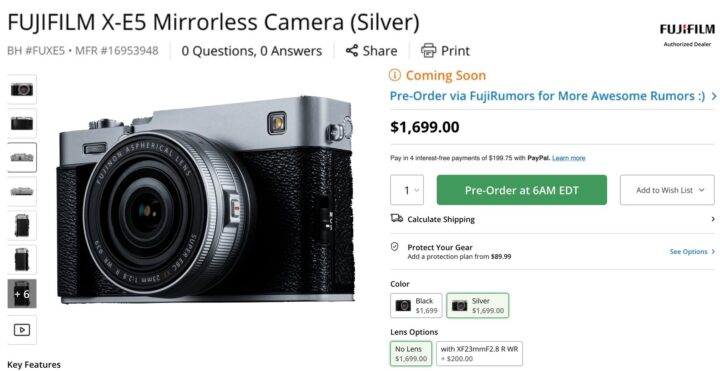Fujifilm X-E5 and XF23mmF2.8 Preorders Start at 6:00 AM New York Time (X Summit at 5AM) and Here are the Links
Many asked me (such as here and here): when can you preorder the X-E5 and the XF23mmF2.8 R WR?
Well, we have the answer.
Pre-orders will start when the X Summit ends.
So, the X Summit is at 5AM EDT and therefore starting at 6:00 AM New York time stores will list the Fujifilm X-E5 on their pages and you’ll be able to preorder it. Same goes for the Fujinon XF23mmF2.8 R WR.
Down below you’ll find the links to the X-E5 at several stores. They might not show the X-E5 right now, but at 6:00 AM New York time they will lead you to the X-E5.
These are affiliate links, which means that if you choose to purchase your X-E5 or XF23mmF2.8 through them, FujiRumors will receive a small commission—at no extra cost to you.
If you feel FujiRumors has earned your support, then this is a nice way to show it.
Just remember: the last affiliate link you click before your purchase determines who gets the commission.
So if you click our link but later click another blog’s or YouTuber’s link before buying, FujiRumors won’t get credited. And that’s totally fine! There are many amazing creators out there who deserve your support. But if your intent was to support FujiRumors, just keep that in mind. It costs you nothing, and your favorite creators will be able to do what they do thanks to your support.
- Fujifilm X-E5
USA: BHphoto / Amazon US (black – silver) / Adorama / Moment / Nuzira / BestBuy / Paul’s Photo
CA: Amazon CA - XF23mmF2.8 R WR
USA: BHphoto / Amazon US (black – silver) / Adorama / Moment / Nuzira / BestBuy / Paul’s Photo
CA: Amazon CA - Fujifilm X-E5 in EU/UK
UK: WexPhotoVideoUK / AmazonUK / ParkCameraUK
GER: AmazonDE / CalumetDE / FotoErhardt / Fotokoch
EUR: 50.8 Shop / PCHstore / AmazonFR / AmazonIT / AmazonES / AmazonNL
Worldwide: Amazon of Your Country - Fujifilm XF23mmF2.8 R WR in EU/UK
UK: WexPhotoVideoUK / AmazonUK / ParkCameraUK
GER: AmazonDE / CalumetDE / FotoErhardt / Fotokoch
EUR: 50.8 Shop / PCHstore / AmazonFR / AmazonIT / AmazonES / AmazonNL
Worldwide: Amazon of Your Country












